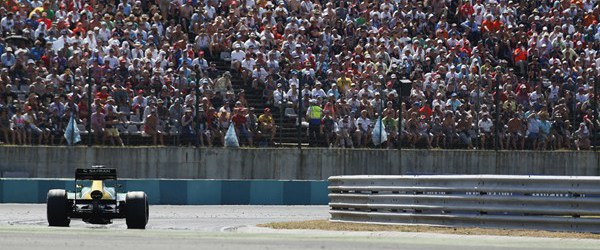
Time is of the essence for all businesses, particularly when milliseconds can mark success. In Formula 1, the pressure for saving time is not just confined to the race track. IT also plays a vital role in a team’s performance and is instrumental to help shave tenths of a second off lap times. Understanding aerodynamics is the key to unlocking speed, and that’s where Caterham F1 Team’s Dell HPC comes in.
Any team who tried to make a car without a HPC solution would be miles off the pace. The driver’s sheer speed and skill is not the only key element that comes into play for on-track success, and HPC technology is fundamental to climbing up the F1 grid.
Sitting in a room which is strictly temperature controlled, the Dell HPC, powered by Intel, is the powerful beast behind the Caterham F1 Team in Leafield Technology Centre- but it seems even more significant in the context of how this type of technology influences Formula 1 racing today.
F1 teams have long relied on wind tunnels for testing parts to find out if they are going to add performance to the car or not, yet the relentless advance of technology has seen those teams make use of Computational Fluid Dynamics (CFD) in tandem with wind tunnel work. CFD is often called ‘a wind tunnel in a computer’ and F1 teams rate this technology highly as it allows them to virtually test how modifications to a car could have an impact on the car’s aerodynamic performance and ultimately its speed.
CFD starts with a process called meshing, which means virtually segmenting the car into millions of tiny cells. These squares are in turn halved into thousands and thousands of tiny triangles. At Caterham F1 Team, the teams’ engineers use CFD to draw detailed information on what is happening with the temperature, pressure, turbulence and velocity inside each triangle that covers the surface of the virtual car. William Morrison, Caterham F1 Team’s IT Infrastructure Manager, explains why this is so important:
"CFD means you can look at the airflow over and through various components of the car, and this simulation allows us to filter so that we can test theoretical developments and match them up to wind tunnel results, before coordinating the two sets of results between each other."
"By trying out a number of different ideas and testing whether they will work or not, it means we are able to carry out development work without actually having to make parts," Morrison explained.
"To purely do development work in a wind tunnel would be very costly and time-consuming because of how long it takes to produce the wind tunnel models; the HPC allows a very quick turnaround of theoretical models before you decide whether to physically make them or not. It’s vital for a modern F1 team to have HPC simulation capability."
The primary function of the supercomputer at Caterham F1 Team is to handle a huge number of of operations at once.
"The HPC typically has about six ‘jobs’ going through it at any one time, which could last anything from six hours to two days each," says Morrison.
"For an average 17-hour job the HPC will do approximately ten billion calculations."
To put that in context, the average PC you might have at home to surf the internet would take between four and five months to get through that amount of maths.
The calculations the HPC does are not simple either. Partial differential equations are the norm and they reveal everything about how air is flowing in and around the part being tested. Once the HPC has performed its ten billion calculations, it will spend the final two hours of a 17-hour job streamlining these to about 800 million pieces of individual data, which will then be presented to the CFD analysts in video, graph and picture form.
"What we get from this is a different insight into the aerodynamics, because you’re getting a full 3D flow simulation," explains Morrison.
"You’re seeing the complete flow structures of air off the body of the car."
"It used to be that a typical job may be 17 hours," explains Morrison, "but this has recently come down to about 12. This has been done through enhancements to the model set-up, and optimising the way the model solves. There is constant work being done to improve the performance of the calculations so it’s quicker and more reliable. We have a little group of about three people dedicated to improving this all the time. We’re always looking to reduce the solve time because that means we can get more jobs through it per day."
So given the importance of the work constantly going through the HPC, what happens in the event of an unwanted event like a power cut?
"We have battery conditioning units so that there’s always conditioned power coming into the HPC, and if there’s a disruption to the external power supply we’ve got a generator outside which kicks in automatically," says Morrison.
"If the HPC was running at full power and the electricity suddenly went off, the generator would be able to keep it going for a few hours."
Saving time is a constant battle for any team in the F1 circuit and for Caterham F1 Team the Dell HPC is the nerve centre of the entire operation. Without it their car simply could not be designed or developed, which is why the HPC runs 24 hours a day, 365 days a year – always with a queue of between ten and twenty jobs waiting to be solved by powerful calculating prowess.
"December is one of the busiest times of the year in Formula 1, so the HPC is still working flat out even on Christmas Day," laughs Morrison.
"It’s not allowed any time off."






